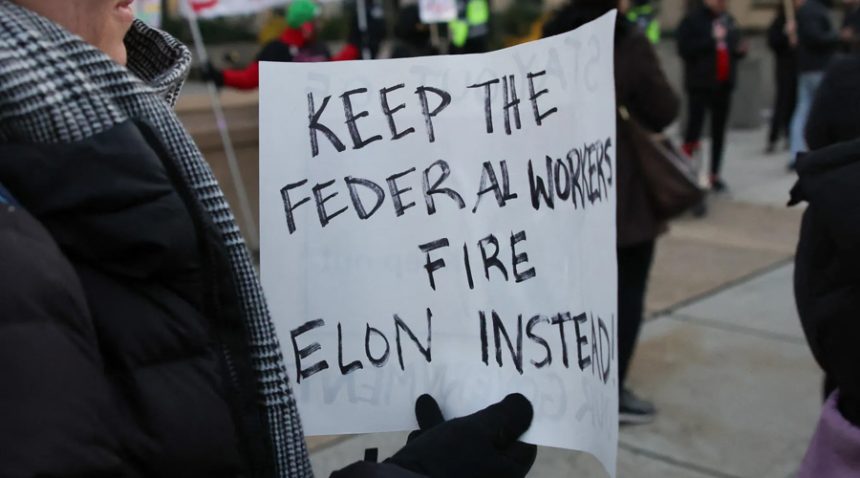The sudden and extensive nature of these layoffs has elicited strong reactions from federal workers
The U.S. federal workforce is experiencing unprecedented upheaval due to mass layoffs initiated by the Trump administration. These actions, spearheaded by President Donald Trump and adviser Elon Musk through the Department of Government Efficiency (DOGE), aim to significantly reduce the size of the federal government. The rapid implementation of these measures has led to widespread confusion, anger, and legal challenges among federal employees.
Scope of the Layoffs
The administration’s strategy focuses on terminating probationary employees—those with less than one year of service, or two years for certain positions—who lack full civil service protections. This directive has resulted in the dismissal of approximately 10,000 federal employees across various agencies. Notable examples include:
Department of Veterans Affairs (VA): Over 1,000 employees have been laid off, raising concerns about the potential impact on veteran services.
Department of Health and Human Services (HHS): Approximately 5,200 staff members have been dismissed, affecting critical areas such as the Centers for Disease Control and Prevention (CDC), which saw 1,300 employees terminated.
Environmental Protection Agency (EPA): 388 employees were initially reported as laid off, though this figure was later corrected.
These layoffs are part of a broader initiative to downsize the federal workforce, with some reports suggesting targets of reducing staff by 30% to 70% in certain agencies.
Employee Reactions
The sudden and extensive nature of these layoffs has elicited strong reactions from federal workers:
Shock and Confusion: Many employees received abrupt termination notices, leading to widespread uncertainty about their employment status and future prospects.
Anger and Resentment: The perceived lack of transparency and due process has fueled feelings of betrayal among long-serving civil servants.
Legal Challenges: Federal employee unions have filed lawsuits against the administration, alleging that the mass firings violate established labor laws and protections.
Specific Agency Impacts
The repercussions of the layoffs vary across agencies:
National Nuclear Security Administration (NNSA): Approximately 350 employees were initially laid off, including those involved in critical nuclear security roles. Following widespread alarm over potential risks to national security, the decision was partially reversed, reinstating most of the affected workers.
Federal Aviation Administration (FAA): Several hundred probationary employees, including air traffic controllers and safety officers, were dismissed. This has raised concerns about increased workloads and potential safety implications in the aviation sector.
Department of Housing and Urban Development (HUD): Plans are underway to cut up to 50% of HUD’s 9,000 employees, which could severely impact services related to housing assistance and urban development.
Administrative Justifications
The Trump administration defends the layoffs as necessary measures to eliminate government waste and enhance efficiency:
Budgetary Concerns: President Trump and Elon Musk argue that reducing the federal workforce will save taxpayers up to $1 trillion by cutting unnecessary expenditures.
Performance and Accountability: The administration emphasizes the need for a leaner government structure, asserting that only the most competent and dedicated employees should remain in public service.
Criticism and Legal Challenges
Despite the administration’s rationale, numerous criticisms and legal obstacles have emerged:
Lack of Due Process: Legal experts contend that the mass terminations, especially those conducted without prior notice or justification, may violate federal employment laws designed to protect workers’ rights.
National Security Risks: The abrupt dismissal of personnel in sensitive positions, such as those within the NNSA and FAA, has prompted concerns about potential vulnerabilities in national security and public safety.
Erosion of Public Services: Critics warn that significant reductions in staffing levels could undermine the government’s ability to deliver essential services, adversely affecting public health, safety, and welfare.
Future Outlook
The situation remains fluid, with several potential developments on the horizon:
Judicial Intervention: Multiple lawsuits filed by unions and employee advocacy groups are progressing through the courts. The outcomes of these cases could determine the legality of the layoffs and potentially lead to reinstatements or changes in policy.
Legislative Responses: Some members of Congress have expressed opposition to the mass firings and may introduce legislation aimed at protecting federal employees’ rights and limiting executive overreach.
Long-Term Implications: The restructuring of the federal workforce could have lasting effects on government operations, employee morale, and the attractiveness of public service careers. The full impact of these changes will unfold over time, influencing the future of federal employment and governance in the United States.
In summary, the mass layoffs of U.S. federal workers have led to a complex interplay of administrative objectives, employee reactions, legal challenges, and broader societal implications. As the situation evolves, the balance between governmental efficiency and the preservation of a competent, motivated civil service remains a critical focal.






